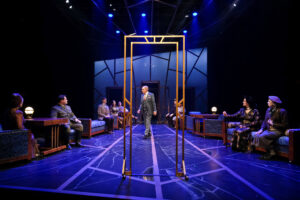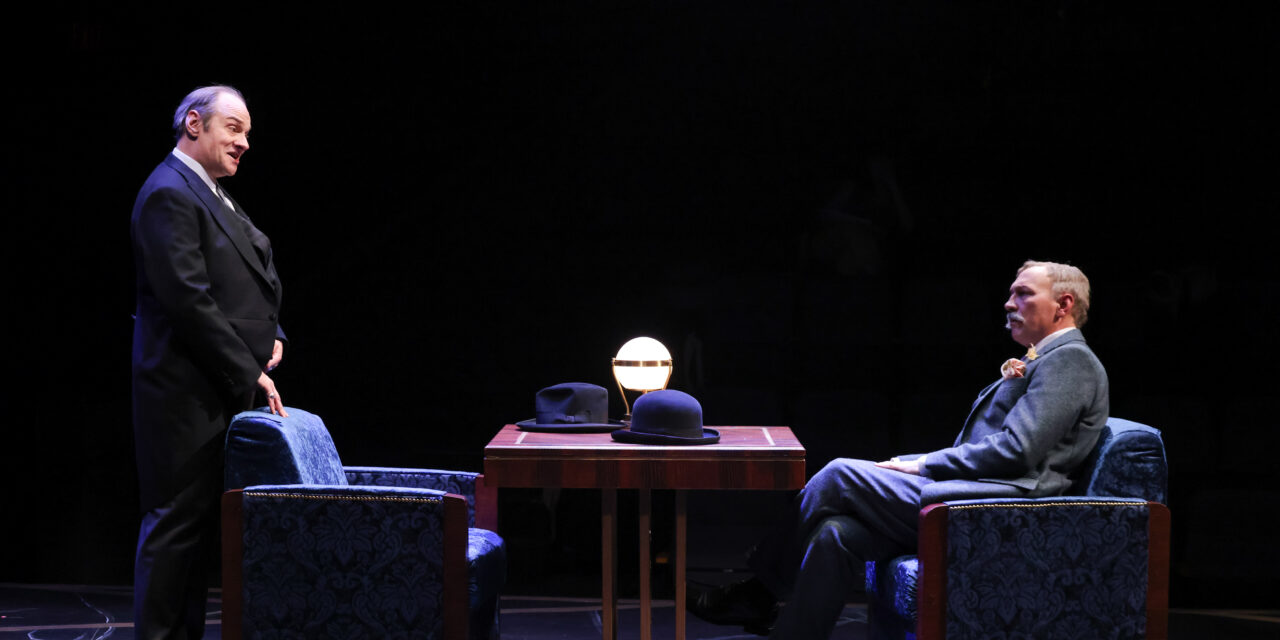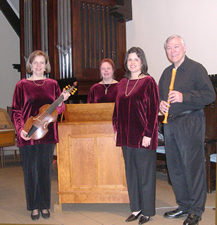Above: Mr. Ratchett (Jim Roof) and Hercule Poirot (Jeffrey Blair Cornell) face off in MURDER ON THE ORIENT EXPRESS. credit: Photo by HUTHPhoto.
Composer Philip Glass was refreshingly candid when I interviewed him for The News and Observer in 1999. At the time, he observed that 1000 Airplanes on the Roof, his sci-fi collaboration with breathtaking visual designer Jerome Sirlin and playwright David Henry Hwang, was a melodrama – and a rather good one, he thought.
Full stop. No muss, no fuss.
The moment was striking enough to send me back to the textbooks for a reminder about the definition. True enough, the earliest melodramas were stage plays with music interspersed throughout to add emotional impact to the dialogue (as conveyed in the name itself: melos, for music, plus drama). It wasn’t until later works in the 19th century took this and other theatrical extravagances ever further, as their characters vended increasingly exaggerated emotions and conflicts in overdramatized spectacles of morality and sentiment, that the term took on its present, less respected, definition.
(By that yardstick, Glass’ work still met the terms, as its unstable central character most reluctantly confessed to having been abducted by aliens, and Sirlin’s fantastical 3-D visuals and Glass’ soaring music swept us up and along for the ride.)
By itself, then, a classic murder mystery along the lines of Agatha Christie’s work is already taking us in the direction of melodrama. And when you place it on the most opulent train in the world, that’s been populated with exotic characters from a number of different continents and cultures, rest assured, you’ve arrived.
And you’re in perfectly good company when you’ve done so. Entire genres, including romance, horror and action-adventure tales in film and literature as well as theatre, are built on it.
So, it’s not a bad thing that Murder on the Orient Express is a melodrama.
What’s unfortunate, though, is that it’s not a very good one.
French poet Paul Valéry once observed that a work of art is never finished, but merely abandoned. But the cut corners and unambiguous theatrical problems left behind on stage in this PlayMakers Rep production constitute the show’s biggest reveals, greater even than the identities of the murdered or those what done it.
To start, it’s astounding that the estate of Agatha Christie signed off on Ken Ludwig’s workmanlike script, which excises a full third of the suspects in the original text (and both popular screen adaptations) from twelve to eight. Such a move is more often associated with the “junior” versions of Broadway musicals licensed for grade and high-school student productions.
Then there’s Tony Cisek‘s deeply problematic set design, which permited director Tracy Bersley‘s formless staging to sprawl across the expanse of Paul Green Theatre. It would have been more difficult to realistically stage the drama within anything approaching the actual dimensions of the Simplon Orient Express, but it’s doubly unfortunate that this creative team apparently never tried, in a miscalculation similar to the one that sandbagged PlayMakers’ recent production of Misery. The claustrophobia and paranoia that could have been explored along narrow, dimly lit corridors and small, self-contained chambers, isolated and surrounded by darkness, could plausibly have added to a psychological suspense that’s largely missing here.

Stretching out: Hercule Poirot (Jeffrey Blair Cornell) grills the suspects in MURDER ON THE ORIENT EXPRESS. credit: Photo by HUTHPhoto.
But when Cisek’s improbable, free-ranging herd of tasteful tables, chairs and furnishings repeatedly goes roaming, hither and yon, during the show’s awkward set changes, the absurd results shatter the metaworld, and suggest sleeping berths designed by Marcel Duchamp – that, or a Murder in a Haverty’s Furniture Showroom instead.
On the other hand, the strategy adds the tinge of a theatrical steeplechase when several cast members inevitably attempt to chew on the frequently moving scenery. It’s understandable here when Bersley directs the veterans in the cast to aim for the broadest sides of the barn, and gratifying enough when they hit it. There’s no doubt at all that Hope Alexander‘s dowager Russian battleaxe, the forbidding Princess Dragomiroff, is not only capable of murder, but would be the one most likely to get an old-fashioned kick out of it. If anything, Julia Gibson lays it on even thicker as Helen Hubbard, the inexhaustible Minnesotan maven on the make. Jim Roof nails the other ugly American aboard, the pushy import/export businessman, Ratchett.
Unsurprisingly, associate artistic director Jeffrey Meanza plays the hero’s companion, Monsieur Bouc, with effervescent savoir-faire. But the director largely fails her brace of grad student actors, who remain too easily identifiable here in their underdeveloped characterizations: Matthew Donahue‘s unconvincing Col. Arbuthnot, who has insufficient chemistry with Saleemah Sharpe‘s more transparent Mary Debenham, Adam Valentine‘s better Hector, Hayley Cartee‘s insufficiently polished Countess, and the cipher of Reez Bailey‘s porter, Michel.
The resulting ensemble of characters in various stages of construction forms a treacherous set of surfaces for company member Jeffrey Blair Cornell to bounce off of, as the carefully calibrated – and constricted – central figure, detective Hercule Poirot.
It’s no accident in the original text when twelve suspects also reference the number required for a jury in a capital case, where the death penalty can be imposed. When would-be avengers threaten here to also serve as judges and potential executioners, Poirot, a sleuth of the old school and the old world, rails against vigilante justice. “The law must be obeyed or we become barbarians! It is 1934, Europe is changing and there will be chaos,” an impassioned Poirot asserts in Ludwig’s script.
The words are obviously prophetic, and they don’t just point to the coming war of that time. They carry an uneasy resonance in a present hour when zealots of another stripe seek to replace the rule of law with something that they think will give them an even more desperately desired revenge.
Small wonder, then, that Poirot doesn’t sleep well thereafter. Neither should we.

The cast, in National Women’s Theatre Festival’s DANCE NATION. credit: Photo by Erin Bell / Bull City Photography.
Speaking of insoluble theatrical problems, the National Women’s Theatre Festival faced this one on last week’s opening night of Dance Nation, the company’s mainstage production at Theatre Raleigh‘s second-stage studios on Barrow Road.
One day before opening, actor Jim Bray, who played Santa in NC Theatre’s recent production of Elf, was let go, leaving producer Noelle Azarelo (instead of listed understudy Matthew Hager) to go on stage in his place, book in hand, as the group’s foil, self-centered Dance Teacher Pat. (In subsequent, unreviewed performances, actor Nick Popio has replaced them both in the role.)
Changes keep a show fresh, the saying goes. But to their credit, an apparently shockproof cast rose to the challenge with a self-assured run of Clare Barron’s harrowing coming-of-age comedy about a group of privileged, prepubescent girls trapped in what might just be the worst of all possible children’s dance studios.
Since it takes the worst of all possible dance teachers to make the worst studio, Dance Teacher Pat (who, of course, is never referred to by just their first name) sets the culture up as a cut-throat, zero-sum rat race – you know, just like the real world. In this false aesthetic antiworld, insecure girls endlessly curry favor to headline in what the smartest will one day realize were meaningless competitions filled with choreography that was largely ad hoc and mediocre at its very best. At the same time, Barrow writes in sequences off the studio floor of young girls attempting to connect with primal natural forces in their own bodies and the world around them, linking the ferocity of wolves with their own nascent, budding desires for agency and power. Imagine a younger girls’ version of Lord of the Flies, with a smidgen of Agnes de Mille mixed in, and you’re on the right track.
Under artistic director Johanna Maynard Edwards, there is an aching poignancy in the faltering friendship between the dance instructor’s chosen star, Amina (Tatiana Burrus) and Zuzu (Riki R. Dows), who Pat ever so subtly undermines. When Amina begins to not-so-subtly follow suit, Sanchi Pandey‘s Connie fiercely calls her on it. Later, when Amina tries, too late, to repair the betrayal, there’s devastation and real heartbreak when Zuzu says, “I’m not mad. I just can’t really look at you right now.”
Clare Sherk gives an eerie, authoritative performance as Ashlee, a girl whose internal confidence in her body, mind and emerging sexuality collides with fears that are equally deep-seated. After a thorough, in-your-face inventory of her assets, Ashley concludes, “I never say this stuff to anybody because I’m afraid they’re going to hate me… And sometimes it makes me feel ashamed…And I want to bury it down deep. Never acknowledge it. Keep my eyes on the pavement when I feel men looking at me and just pretend I don’t exist.”
When these and other forces stay bottled up within a group of 13-year-old girls, something’s got to give. And it does.
Composer Matthew Hager* clearly has subversive fun with the lyrics and the music for the various routines, and choreographer Alli Mae Carnes ably mocks would-be dancemaker Pat’s terpsichorean excesses, including a truly dubious tribute to Mahatma Gandhi. Still, the pensive piano breaks that Barrow over-relies on in her script’s multitudinous transitions take on a certain sameness after a while.
They also pose a significant challenge to the show’s momentum, since it’s clearly a lengthy and ongoing struggle to lug designer Margaret Toomey’s oversized wooden platforms across stage during so many transitions. As a result, Edwards winds up giving Nat M. Sherwood and Riley Yates steadily increasing visibility in comic but still superfluous roles as occasionally upstaging stagehands.
As the girls become more adept at tapping into the energies in the world, their bodies and the cultural structures that surround them, they and we discover that those dynamics can bring out both the humane and the monstrous within us. How – or if – they can co-exist in each of us is one of the continuing questions we’re left with in this uneasy nation.
Playmaker’s Murder on the Orient Express continues through March 24. Dance Nation will complete its run on March 17. See our calendar for more details.
*Matthew Hager is the theatre editor for CVNC.org and did not have any part in the review or editorial aspects of this piece.














